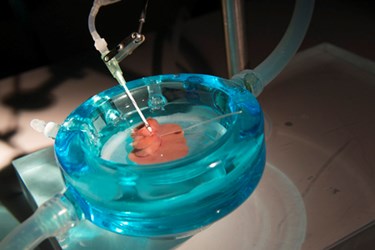Supercooling Technique Extends Life Of Transplant Organs
By Joel Lindsey

In an ongoing study, a team of researchers affiliated with the National Institutes of Health (NIH) may have devised a new method of organ preservation that could dramatically increase the length of time an organ can be stored outside the body before being transplanted.
“The longer we are able to store donated organs, the better the chance the patient will find the best match possible, with both doctors and patients fully prepared for surgery,” Rosemarie Hunziker, program director of tissue engineering and regenerative medicine at the NIH’s National Institute of Biomedical Imaging and Bioengineering (NIBIB), said in a press release published recently on the NIH website. “This is a critically important step in advancing the practice of organ storage for transplantation.”
In the study, researchers devised a new organ preservation technique that enabled them to successfully preserve rat livers for three and four days. The first step of the new technique was to introduce the livers to machine perfusion — a mechanized way of delivering oxygen and crucial nutrients to biological tissues — to ensure that the organs would not experience severe damage while being cooled.
To enable machine perfusion, the team added a highly specialized cocktail of compounds to the solution being delivered to the liver, including 3-OMG (3-O-methyl-D-glucose) and PEG-35kD (polyethylene glycol). Because the 3-OMG was absorbed by the liver’s cells but not metabolized, it accumulated into a protective layer that guarded cells from being harmed by the cold temperatures required to preserve the organ. Similarly, PEG-35kD served as an anti-freeze, lowering the freezing point of the entire solution.
The livers were then slowly cooled to 21° F. Protected against freezing by the solution, the livers became what researchers called “supercooled.” In this state, the livers survived for durations of three days and four days before being gradually rewarmed via machine perfusion and then used in actual transplantations.
According to the press release, rats that received livers that had been stored for three days all lived for an additional three months, and the survival rate for rats that received livers stored for four days was 58 percent.
Researchers said that the preservation times achieved with this new technique were significantly longer than those achieved using current organ preservation methods, which are typically capped at 24 hours outside the body.
“The next step will be to conduct similar studies in larger animals,” said Hunziker. “It is exciting to see such an achievement in small animals, by recombining and optimizing existing technology. The main point here is that using all of these approaches at once was what led to success. Halfway measures did not do. Such a tour de force reflects this team’s very deep understanding of the complex processes at work here, and how they relate simultaneously to each other.”
Details and results from the study have been published recently in the journal Nature Medicine.
